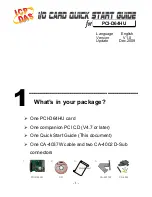
User's Guide Fireface 802
© RME
43
Input
Thanks to a highly sensitive input stage
SPDIF coaxial can be fed too by using
a simple cable adapter phono/XLR. To
achieve this, pins 2 and 3 of a male
XLR plug are connected individually to
the two pins of a phono plug. The cable
shielding is only connected to pin 1 of
the XLR - not to the phono plug.
In AES operation, identical signals are available at both the optical and the XLR output. An ob-
vious use for this would be to connect two devices, i.e. using the Fireface 802 as a splitter (dis-
tribution 1 on 2).
Output
Using the cable adapter XLR/phono described above, devices with coaxial SPDIF interface can
be connected to the AES output of the Fireface 802 as well. Note that most consumer equip-
ment with phono (SPDIF) inputs will only accept signals having a Channel Status ‘Consumer’
format. The Consumer status is activated in the Settings dialog of the Fireface 802. In Con-
sumer mode the output voltage is reduced as well, as SPDIF calls for a lower voltage than
AES/EBU.
The output signal coding of the Fireface 802 has been implemented according to AES3-1992
Amendment 4:
•
32 / 44.1 / 48 kHz, 64 / 88.2 / 96 kHz, 176.4 / 192 kHz depending on the current sample rate
•
Audio
use
•
No Copyright, Copy permitted
•
Format Professional or Consumer
•
Category General, Generation not indicated
•
2-Channel, No Emphasis
•
Aux Bits Audio use, 24 Bit
•
Origin:
RME
21.3 MIDI
Fireface 802 has a MIDI I/O via four 5-pin DIN sockets. The MIDI ports are added to the system
by the driver. Using MIDI capable software, these ports can be accessed under the name
Fire-
face MIDI
. Using more than one Fireface, the operating system adds a consecutive number to
the port name, like
Fireface MIDI (2)
etc.
The MIDI ports support multi-client operation. A MIDI input signal can be received from several
programs at the same time. Even the MIDI output can be used by multiple programs simultane-
ously. However, due to the limited bandwidth of MIDI, this kind of application will often show
various problems.
Note: The MIDI input LEDs display any kind of MIDI activity, including MIDI Clock, MTC and
Active Sensing. The latter is sent by most keyboards every 0.3 seconds.
Summary of Contents for Fireface 802
Page 7: ...User s Guide Fireface 802 RME 7 User s Guide Fireface 802 General...
Page 12: ...12 User s Guide Fireface 802 RME...
Page 13: ...User s Guide Fireface 802 RME 13 User s Guide Fireface 802 Installation and Operation Windows...
Page 28: ...28 User s Guide Fireface 802 RME...
Page 29: ...User s Guide Fireface 802 RME 29 User s Guide Fireface 802 Installation and Operation Mac OS X...
Page 38: ...38 User s Guide Fireface 802 RME...
Page 39: ...User s Guide Fireface 802 RME 39 User s Guide Fireface 802 Inputs and Outputs...
Page 47: ...User s Guide Fireface 802 RME 47 User s Guide Fireface 802 Stand Alone Operation...
Page 50: ...50 User s Guide Fireface 802 RME...
Page 51: ...User s Guide Fireface 802 RME 51 User s Guide Fireface 802 TotalMix FX...
Page 53: ...User s Guide Fireface 802 RME 53...
Page 89: ...User s Guide Fireface 802 RME 89 User s Guide Fireface 802 Class Compliant Mode...
Page 94: ...94 User s Guide Fireface 802 RME...
Page 95: ...User s Guide Fireface 802 RME 95 User s Guide Fireface 802 Technical Reference...
Page 106: ...106 User s Guide Fireface 802 RME 36 Diagrams 36 1 Block Diagram Fireface 802...
Page 108: ...108 User s Guide Fireface 802 RME...
Page 109: ...User s Guide Fireface 802 RME 109 User s Guide Fireface 802 Miscellaneous...
















































